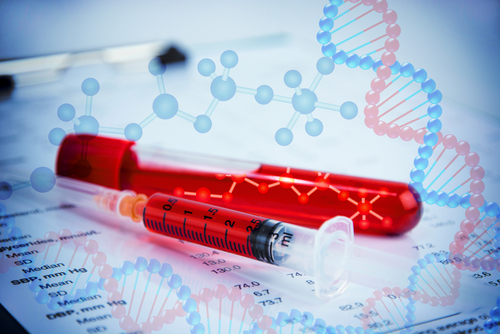New Early Data Support Catalyst’s MarzAA in Treating Acute Bleeds in Hemophilia

New preclinical data on one of Catalyst Biosciences‘ lead candidate therapies — marzeptacog alfa activated (MarzAA), an engineered clotting Factor VIIa (FVIIa) given as an under-the-skin injection — support its potential to treat acute bleeds in people with hemophilia and its ability to be used safely in combination with Hemlibra (emicizumab).
Following promising results in a Phase 2 trial (NCT03407651) indicating that MarzAA significantly lowers the number of bleeding episodes in patients with hemophilia A or B with inhibitors (anti-drug antibodies), these new data further support the launch of a Phase 3 trial expected to open next year, Catalyst says.
The findings were presented by Grant Blouse, PhD, Catalyst’s vice president of translational research, in two posters at the 61st Annual American Society of Hematology (ASH) meeting, held Dec. 7-10 in Orlando, Florida.
“The data presented in these posters demonstrate the broad potential of MarzAA as an effective and safe [subcutaneous, or under the skin injection] therapy in hemophilia and fuels our commitment to initiate a MarzAA Phase 3 study in 2020. We believe MarzAA could significantly improve the quality of life of individuals with hemophilia or other bleeding disorders,” Nassim Usman, PhD, Catalyst’s president and CEO, said in a press release.
“There is a significant need for a safe, subcutaneously administered treatment and we believe MarzAA could play an important role in improving these individuals’ lives,” Usman added.
MarzAA is a new recombinant (lab-made) Factor VIIa designed for long-term prevention of bleeding episodes in patients with hemophilia with inhibitors, acquired hemophilia, and other bleeding disorders. It combines higher clot-generating activity and longer activity at the site of bleeding.
Unlike other clotting factor-based products used for prophylaxis (prevention) of bleeding episodes, MarzAA can be given by injections under the skin (subcutaneous injection), a less invasive method to conventional injections into a vein (intravenous).
MarzAA is also being explored for the treatment of acute bleeds, either given subcutaneously or intravenously.
Data presented in the first poster, “Fast Onset of Action of Subcutaneously Administered Marzeptacog Alfa (Activated) Supports On-Demand Treatment in Hemophilia A Mice,” showed that subcutaneous injections of MarzAA given one minute after injury — to mirror ‘on-demand’ or rescue therapy — significantly reduced bleeding in mouse models of hemophilia A.
Bleedings were also reduced in a dose-dependent manner if MarzAA when given as late as 15 minutes before the injury.
Of note, MarzAA’s ability to restrain bleeds was comparable to that of Novo Nordisk‘s NovoSeven (recombinant FVIIa; eptacog alfa, activated) — a therapy used to treat or prevent bleedings.
According to researchers, the data suggest that “MarzAA can be used on-demand to treat acute bleeding” and support further clinical testing as a treatment of bleeds in people with hemophilia, or who have a FVII deficiency.
In the second poster, “The Combination of Marzeptacog Alfa (Activated) or Eptacog Alfa (Activated) with Emicizumab Appears Comparable as Assessed by the Thrombin Generation Test in Hemophilia A,” Blouse shared data providing evidence that it will be safe to use MarzAA in combination with Hemlibra, Roche‘s prophylactic therapy for hemophilia A.
In laboratory tests, both MarzAA and NovoSeven were equally effective at triggering blood coagulation — as tested by thrombin-generation assay — when added to the plasma of patients with hemophilia A at clinically relevant concentrations.
Patients on prophylaxis with Hemlibra may experience breakthrough bleeds — bleeding despite preventive treatment — or require additional treatments for certain procedures or surgery.
Therapies used with Hemlibra include Takeda‘s Feiba (an anti-inhibitor coagulant complex) and NovoSeven. However, the first has been associated with thrombotic events (when a blood clot blocks a vessel). NovoSeven is infused intravenously.
Ideally, add-on therapy for patients on Hemlibra would be given subcutaneously, as is Hemlibra itself, and MarzAA provides a potential solution to that.
“This provides a rationale for eventual clinical development of MarzAA as a [subcutanecous] rescue therapy for hemophilia A patients experiencing breakthrough bleeds while on Hemlibra prophylaxis,” the researchers wrote.
Catalyst is also developing a second lead compound — dalcinonacog alfa (DalcA) — as a preventive treatment for hemophilia B patients, which is currently on a Phase 2b clinical trial (NCT03995784).






